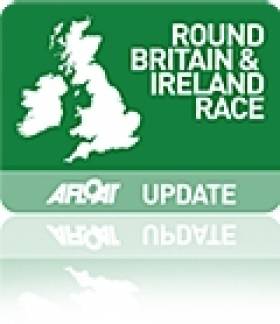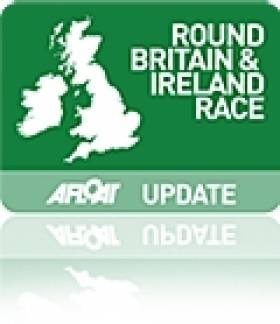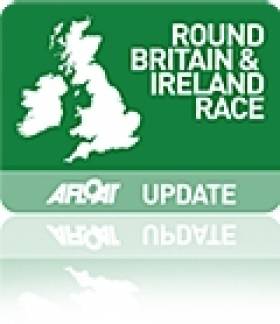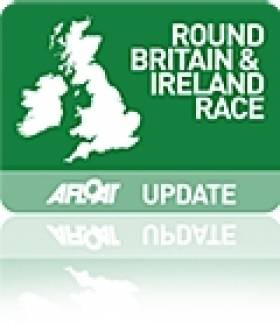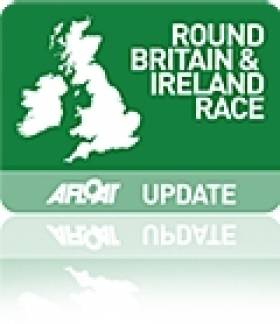Displaying items by tag: Round Britain and Ireland Race
RNLI Is Charity Partner For Round Britain & Ireland Race 2014
#RB&I2014 - The Royal Western Yacht Club of England announced today (Friday 24 January) that the RNLI is the chosen charity partner for the 2014 edition of the Round Britain and Ireland Race.
The two-handed event, which will start on 1 June, is run every four years and first began back in 1966. The race starts and ends in Plymouth with stopovers in four ports, each with an RNLI lifeboat station.
Entries are now being accepted for the race, which is open to all yachts and multihulls between 30 and 50 feet in length and crewed by two people only.
The event has become an international classic, attracting many famous names over the years. Race Director Alan Nichols says: "The course runs clockwise around all of Great Britain and Ireland with compulsory stops at Kinsale, Barra, Lerwick and Lowestoft where the hospitality is legendary.
"It is a huge test of endurance and seamanship and definitely not for the faint hearted. In fact we require entrants to complete a qualifying voyage before their final entry is accepted."
Nichols adds that the RNLI "has a vital presence in Plymouth and each of the stopover ports and it seemed entirely appropriate that we should invite the charity to join us as our partner for the 2014 event.
"Their volunteers are our guardians if you like and those of us who enjoy such racing appreciate knowing that they are on standby to help us 24 hours a day and seven days a week. The RNLI also believe in prevention rather than cure and we hope our joint belief in safety at sea will be reinforced by this liaison."
Entries are now open for the race with all the relevant details available on the Royal Western Yacht Club website HERE.
"We’ve already received some early entries so I would urge people not to leave it too late to express an interest in competing," says Nichols. "In the meantime, there are a number of sponsorship opportunities for businesses wanting to become involved in this iconic event."
Interested companies should contact the Royal Western Yacht Club at +44 (0) 1752 660 077.
Meanwhile, RNLI community fundraising manager Guy Botterill says the partnership between the race and the charity is clear.
"There’s the RNLI presence at each of the ports the race goes to, the obvious belief on both sides that safety at sea is paramount and the fact the RNLI will be there if anyone does get into trouble.
"What’s more the race has in the past attracted entries from RNLI people, including Pip Hare, who works for our coastal safety department in Poole, and Adam Littlejohn, who is based in the southwest and works for our shoreworks department.
"I’d like to thank the Royal Western Yacht Club for this very kind invitation to be the charity partner and we look forward to a successful association before, during and after the 2014 event."
Cammas Sets New Round Britain and Ireland Record
Groupama completed the 1802 mile course in 5 Days 21 Hours 26 minutes and 55 seconds, smashing the course record by 14 hours 3 minutes and 8 seconds.
There were emotional scenes on board as Franck Cammas and his crew crossed the finish line. It was a triumphant finale for Groupama in sharp contrast to the star, when they were the last boat to cross the line, after they had been damaged on their mooring.
"I definitely preferred the finish to the start," smiled Franck Cammas, surrounded by the media dockside after the finish. "It was difficult for us to give away five miles to Teléfonica, but very nice for all of the boats to see us charging through them in the Solent. This race has been so helpful to Groupama. The course is like a mini Volvo Ocean Race. It has all of the different conditions that we will encounter and it has been really good to race against Teléfonica. The crew has really got to know each other well and we have made some fantastic progress in our development over the last few days. Best wishes to everyone who will finish the race, it is a great achievement."
Heading Home in Round Britain and Ireland Race
By sunset tonight all of the competitors racing in the Sevenstar Round Britain and Ireland Race will have rounded Muckle Flugga. For many of them it has been a long hard slog up the North Sea writes Louay Habib.
The leaders are literally at the other end of the course. At 1200 BST, Volvo Open 70, Groupama is just 65 miles from the Scilly Isles. They have chosen a course north of the rhumb line, presumably to take advantage of any new breeze that may emanate from the Bristol Channel. Teléfonica has gybed south and it is anticipated that Groupama will cover them. Groupama have 290 miles to go to the finish of the Sevenstar Round Britain and Ireland Race; Teléfonica are 20 miles behind. Both are expected to finish in Cowes by Sunday afternoon. Obviously this estimated time of arrival will be dependent on the wind strength.
The overall lead under IRC has changed yet again, Piet Vroon's Ker 46, Tonnerre de Breskens is back in the lead. The Dutch yacht is blasting down the west coast of Ireland trying to hang on to the coat-tails of the British Keelboat Academy's TP52, John Merricks II. Before the start of this epic race, the young team were desperately short of funds and up until the last minute, they did not know if they could afford to enter. None of the crew is paid to race, but maintaining and provisioning a TP52 is an expensive business; feeding 18 people for over a week is a huge amount of food. Before the start, they got a helping hand: "This is a tough race and when we heard that the young talented sailors on John Merricks II needed a hand, we were delighted to help," commented ICAP Leopard's Boat Captain, Chris Sherlock. "Racing a TP52 1800 miles takes some doing, but they won't be going hungry. John Merricks are really tight on budget, so with the compliments of ICAP Leopard, they have enough freeze-dried meals to get them around the gruelling course. Best of luck to them."
Doug Innes' First 40.7, Cheeki Rafiki rounded Muckle Flugga in the early hours of the morning. Crewman Ken Allison sums up what it was like to be so far north: "The coldest night so far, up the northwest coast of Shetland, round to Muggle Flugga (isn't that a name you want to spell badly). The phones and internet all sprang into life as we got close to Shetland and civilisation. This gave our first glimpse at how the race has been going for three days. It's great to receive emails and texts from friends and loved ones, wishing us well and offering advice. Plan A seems to be: try to break things less often, trim things more often and keep pushing south. That works for me."
High pressure is working its way across the racecourse from the southwest, giving the fleet far more pleasant conditions. However, for the competitors approaching the west coast of Ireland, there is still a decent moderate breeze from the northwest, pushing them on to finish this challenging race.
Groupama Sets Pace Round Britain and Ireland
Almost exactly two days into the Sevenstar Round Britain and Ireland Race, Franck Cammas' Volvo Open 70, Groupama, was the first yacht to round Muckle Flugga at 1400 BST. They are now heading southwest at a speed of over 17 knots with their 19-mile lead rapidly increasing over their rivals Telefonica Azul, who are still beating up to Muckle Flugga reports Louay Habib.
Jonny Malbon's IMOCA 60, Artemis Ocean Racing, has 77 miles to go to reach the top of the course and will round the remote island alone, as they have been for much of this race. On board is Olympic 49er medallist, Simon Hiscocks who is very much at home racing a 49er or an extreme 40, but offshore racing is a very new concept to him. (See Simon's video blog http://sevenstar.rorc.org/newsblogsphotos.html
Artemis Ocean Racing is going well and 48 hours into the race they are second overall under IRC behind Piet Vroon's Ker 46, Tonnerre de Breskens. Early leaders on handicap, the British Keelboat Academy's TP52, John Merricks II, are now third overall but sailing further offshore and look to be getting into more breeze.
Meanwhile the young crew on Tony Lawson's Class 40, Concise are feeling the effects of this brutal race. "We are cold, wet and busting a gut to keep up with the bigger boats in front of us." Said Tom Gall, skipper of Concise. "The boat has been like a submarine since we left Cowes and we are living off tea and porridge. Tom Dawson comes from Newcastle, and when we passed his home town, he told us how good the fish and chips are. I must say I was licking my lips when I told him to belt-up. This is a tough, tough race but when I look at the crew around me, I just well up with pride for what we are doing."
In IRC Two, Adrian Lower's Swan 44, Selene, is top of the class and has opened up a nine-mile lead on Harry Heijst's S&S 41, Winsome. This may be down to their secret weapon, Tabasco: "We have more bottles of the pepper sauce on board than we have crew," admitted Adrian. "It helps spice up the bland food and warms up the lads as we go north. We are taking part in this race, partly for the challenge of sailing round our Island non-stop, but also to show that an old boat can be competitive."
Driving rain is sweeping across the racecourse but the good news is that the severe weather predicted for Thursday may well be further south than expected. Lighter conditions may well prevail tonight, but one thing that is certain about the Sevenstar Round Britain and Ireland Race; nothing can be taken for granted.
ENDS/...
The Sevenstar Round Britain and Ireland Race is being tracked with OCTrackers. Each boat is supplied with an OCTracker beacon, a self contained unit that transmits the position of the boat at regular intervals using GPS. You can watch the race as it unfolds by visiting: http://sevenstar.rorc.org/tracking.html
22,000 people are also playing the virtual race game. It's not too late to join the race. Sign up via the website: (http://sevenstar.rorc.org/).
Close Finishes for the Round Britain & Ireland
It was nip and tuck for the double-handed racers in the Shetland Round Britain and Ireland Race on Monday, with the first horde of finishers returning to Plymouth after 2,000 miles and four stopovers, including one in Kinsale. For an hour and a half on Monday afternoon, the finishing horn at the Royal Western Yacht Club line seem to keep sounding. Averaging a finish every nine minutes, after nearly 2000 miles of racing, fellow competitors lined the railings of the Cattewater and the balconies of the Royal Western Yacht Club, to cheer and clap each arrival. The support for each other showed the camaraderie that is built up in the stopovers of the Shetland Round Britain and Ireland Race.
The first boats, the top finishers in the nine-boat Class 40 division made it home on June 25, with the top five finishers all crossing the line in a 38-minute period after a match race to the finish in Plymouth.
On Monday, firts home was Yogo Racing Izara skippered by Oli Young and Sam Goodchild led Thunder II (John Fowler & Warwick Samuel) and then Taika (Kim Vasey & Chris Tibbs) over the line in a period of just over six minutes. This put Taika at the top of the IRC leaderboard.
This was only to last a few minutes as The Shed skippered by Phil Stubs and Pip Hare, crossed the line just over four minutes later, to snatch not only the Class Three win out of the hands of Chris Tibbs and Kim Vasey, but the overall lead in IRC. Rafiki skippered by Ebe Docter and Rein Amels followed shortly afterwards.
There was nearly a half hour break before three more yachts were to cross the line within a minute and a half of each other. Fastrak VII (Nigel Colley & David Bowdler) was fifty three seconds ahead of Allez Van Hee (Tony Van Hee & Bob Beggs), who were forty four seconds ahead of Greyhound (Gerard Schalkwijk & Laura Engel).
Another break followed before Jangada Too (Richard Palmer & Trevor Drew) crossed the line just under half an hour later. Twenty minutes later JBellino (Rob Craigie & Charles Allen) crossed the line to the largest cheer of the afternoon, showing the huge affection and respect that Rob and Charles are held in.
And that isn’t it for the day. With Comedy of Errors closing on the Western Entrance of Plymouth Sound there will be more finishers today, bringing to close a day that will have seen nearly twenty percent of the entire race finish within 90 minutes of each other and nearly a third of the fleet finish in one day.
Not only is the 2010 edition of the Round Britain and Ireland and race living up to its reputation for the friendship and fun, but it looks like 2010 will also be remembered for the incredibly close racing.


























